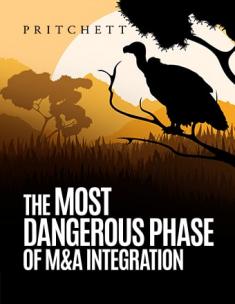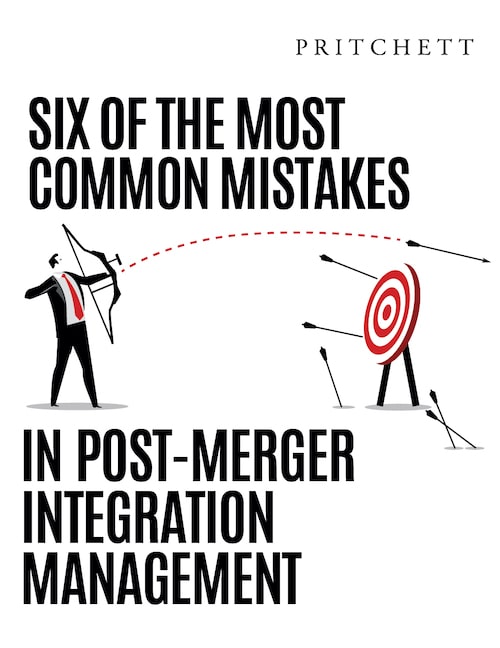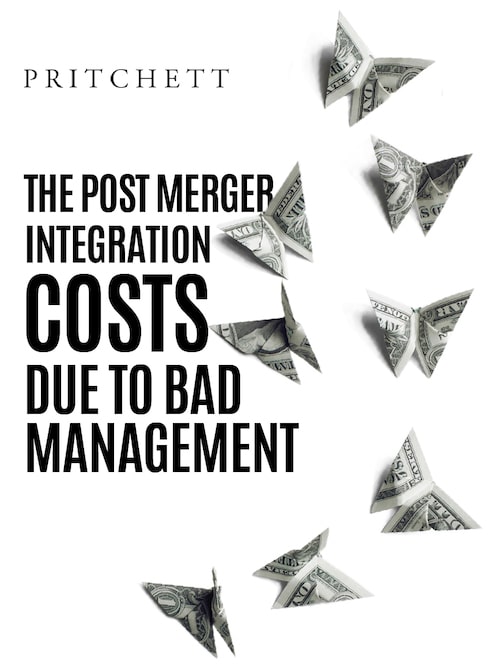The journey from “deal announcement” to “integration complete” is a hazardous trip. You expect problems. But the most treacherous terrain often takes executives by surprise.
INTEGRATION GEOGRAPHY
Let’s divide the merging process into three phases to illustrate the integration pathway:
Phase 1
This phase begins when the deal closes and typically runs through the first two or three months of integration. Sometimes the time frame is conceived as Day 1 through the first 100 days. This period is intense, with many decisions and critical actions as the consolidation process is mobilized. People are scrambling, on high alert. Things are off-balance but moving fast. Uncertainty spikes. You might guess this to be the riskiest time, but bigger challenges lie ahead.
Phase 2
Moving into the second stage of integration, the cadence steadies out. Execution is not as choppy and things probably seem more organized. People feel like there’s more clarity and less pressure, presuming that they’ve gotten past the worst. The organization in general calms down and relaxes a bit ... but this is a very deceptive state. Frequently real trouble lurks beneath the surface, problems that have been simmering and which begin to overheat as Phase 2 unfolds. This is Death Valley, the danger zone where deals most easily start to die. Why? I’ll explain in a moment.
Phase 3
Assuming the unique challenges of Phase 2 are dealt with effectively, the integration process segues into the final work of consolidation. It can take a few more months for the merger to reach a wrap-up point, but this final stage basically consists of nuts-and-bolts implementation. The threat level drops dramatically in Phase 3.
Understanding Death Valley
Now let’s revisit Phase 2 and highlight the hazards. What makes this the most dangerous zone during the integration process? We’ll focus on three common problems, using the words of top executives.
1. “We ‘misunderestimated’ how complicated merger integration would be.”
Executives and managers often go into a merger overrating their competence or discounting the difficulty of integration. Or both. Management teams may skate through Phase 1, only to have the “problems of their solutions” smack them down in Phase 2. Management routinely expects the first couple of months to be the most difficult. But post-merger critiques typically reveal that Phase 2 is where the grinding work of consolidation is most draining and the hard ramifications of change hit home.
2. "We fell victim to ‘decision fatigue'."
Merger burnout begins to manifest in Phase 2 and it introduces a new level of dysfunction. Month after month of constant, heavy-duty decision making finally depletes management effectiveness. Studies repeatedly show that situations like this cause people to physiologically run out of juice. They start looking for excuses to avoid or postpone decisions. They begin to favor the easiest and safest option, which often is perceived to be sticking with the status quo. There’s less willingness to compromise or make trade-offs, as executives stiffen their positions and become more resistant. Particularly if Phase 1 work failed to produce a limited set of clear priorities, the integration starts to drag because people are not only weary, but also unaligned and lacking focus.
3. "Our newly formed executive team just couldn’t get its act together.”
This problem doesn’t show up at first. In the initial stage of team development—which naturally occurs during Phase 1 of the integration—executive behavior is cordial and polite. Conflict is avoided. Social ambiguity is high, though, due to people’s guardedness and hidden agendas. Emotions are concealed, strong personal opinions are toned down, and there’s a reluctance to do anything controversial. Surface appearances can give the impression of friendly camaraderie and suggest that the team is functioning quite well. But usually this is only a veneer.
As integration moves into Phase 2, executives drop their facades and politeness fades. The thinly veiled issues and problems that were previously glossed over have to be dealt with, and the “nice” behavior exhibited in Phase 1 gives way to open disagreement, strained relations, and power struggles. Nerves are on edge. Tempers flare. Cliques and alliances form. The leader’s authority may be challenged. With so much energy and attention devoted to infighting, the team’s performance deteriorates and some executives seriously consider leaving. This is the shakiest point in the integration process, the lowest point in Death Valley, and typically top management doesn’t see it coming.
This helps explain why there are so many bones in the graveyard.





